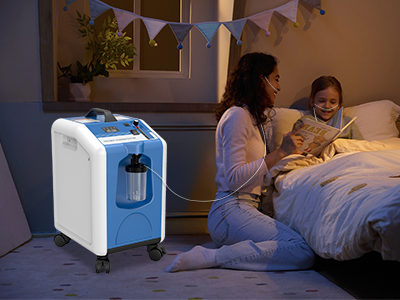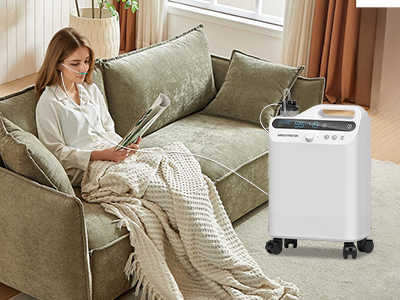18 Jul 2025
Nighttime: that magical window when we shed our daytime stress, wrap ourselves in questionable pajama choices, and attempt eight hours of blissful unconsciousness. For those on oxygen therapy, however, the night holds slightly more responsibility than just picking a side of the bed. That sleek oxygen concentrator humming softly in the background? It's more than a bedtime companion—it's the gatekeeper to restorative rest.
If you or your loved one relies on oxygen at night, welcome to the club of nocturnal nose-hose navigators. Here’s how to transform your sleep sanctuary into a safe, breathable haven.

Start with the Basics—Explain, Don’t Lecture
Children are naturally inquisitive. If you don’t explain what oxygen therapy is, they’ll make up their own version—and spoiler alert: it will probably involve aliens, robots, or an invisible dragon living in the tubing.
Understanding Why Oxygen at Night Matters
During sleep, our bodies go into a low-power mode—like a phone on battery saver. Breathing slows, muscles relax, and oxygen levels can dip. For people with certain respiratory conditions, this dip is less of a gentle slope and more of a nosedive off a metaphorical oxygen cliff. That’s where nighttime oxygen therapy steps in like a polite ninja—silent but essential.
Common Reasons It’s Prescribed:
Sleep apnea with hypoxemia: Because gasping for air is not a lullaby.
Chronic Obstructive Pulmonary Disease (COPD): The lungs forget their job while you're dreaming about cheeseburgers.
Interstitial lung disease: Where breathing becomes more like trying to inhale through a coffee stirrer.
Congenital heart issues: When the heart and lungs are in a long-term, slightly toxic relationship.
Nighttime oxygen ensures the body’s tissues get their nightly oxygen buffet—essential for brain health, organ repair, and waking up not feeling like a soggy sock.
Setting Up Your Nighttime Oxygen Therapy Space
If your bedroom looks like the lovechild of a hospital and a spaghetti factory (tubing, cords, blinking lights), you're not alone. But with a little TLC and design magic, your oxygen therapy setup can feel more spa than ICU.
Essentials to Consider:
Placement of the machine: Position the concentrator where it won’t be tripped over, kicked, or used as a nightstand. Ventilation is key—don’t let it suffocate behind a curtain.
Noise level: Some machines hum like a Zen monk. Others wheeze like a walrus. Consider sound-dampening pads, white noise machines, or a strategic pillow wall.
Tubing management: Use tubing clips or soft sleeves to prevent accidental nighttime entanglement. (No one wants to wake up mid-yoga pose.)
Backup power: A battery backup or generator isn’t just smart—it’s heroic during a blackout.
Make your space oxygen-friendly and aesthetically tolerable. You deserve both breathability and beauty.
Wearing the Equipment Without Losing Your Mind
Let’s talk about nasal cannulas—the plastic unicorn horns of oxygen therapy. Functional? Yes. Glamorous? Not so much. But they’re the lifeline of nighttime O2.
Tips to Make It Bearable (Maybe Even Comfortable-ish):
Go soft: Use soft-touch tubing or padded cannulas. Your cheeks and nostrils will send you thank-you notes.
Hydrate the air: Dry nose? Consider adding a humidifier bottle to your concentrator (check with your provider). No one wants to wake up with a nose that feels like the Mojave Desert.
Anchor it down: Use gentle medical tape or head straps to keep the tubing from migrating onto your cat mid-slumber.
Practice breathing: Sounds obvious, but focusing on slow, deep breaths as you fall asleep can help you adjust mentally and physically.
Comfort is a journey. One adjustment at a time can help make the strange feel second nature.
Common Nighttime Challenges (and How to Outsmart Them)
Nighttime oxygen therapy isn’t without hiccups. Sometimes literal hiccups. Sometimes metaphorical ones.
Frequent Issues & Fixes:
Tubing tangle tango: Use a swivel connector to reduce the twisty-turnies.
Mask leaks (if using a CPAP/O2 combo): Clean the seal regularly and adjust for fit—your face is not a one-size-fits-all.
Dry mouth/throat: Hydrate before bed and consider humidity enhancements. Bonus: You’ll dream of tropical climates.
Oxygen alarms at 3 a.m.: Check for loose connections, kinks, or low flow. Pro tip: Don’t panic—yawning helps you think.
Feeling claustrophobic: Practice during the day. Wear the equipment while reading, watching TV, or yelling at reality shows.
Every glitch has a workaround. Sometimes it’s gear, sometimes it’s gumption.

Tracking Progress While You Sleep
Oxygen therapy isn’t a “set it and forget it” scenario. Monitoring is key to knowing if it’s actually doing its nocturnal magic.
Tools of the Trade:
Pulse oximeter: Measures blood oxygen. Slip it on at night or use models with recording capabilities for your provider to review.
Sleep diaries: Yes, like in high school—but for your lungs. Track how you feel in the morning, if you woke up gasping, or if your dreams involved drowning.
Remote monitoring devices: Some setups sync with apps and let your provider stalk your O2 levels from afar (with your permission, of course).
Keep tabs on your stats. Data tells the story your dreams can’t.
Talking to Your Provider About Nighttime Use
Nighttime oxygen therapy should be personalized, like a tailored tuxedo for your lungs. That means regular chats with your provider are crucial.
Questions Worth Asking:
“Can we re-evaluate my oxygen needs soon?”
“Should I be using oxygen with my CPAP/BiPAP?”
“Is my current setup still the best option for my condition?”
Health changes, sleep patterns evolve, and technology upgrades faster than smartphones. Stay in the loop with your medical team.
Keywords: oxygen therapy
Originally published 18 Jul 2025, updated 18 Jul 2025.